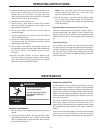
DIAGRAMS
Connection of DC-1500 to NA-5
Above diagram shows electrode connected po-
sitive. To change polarity, turn power off, reverse
the electrode and work leads at the power source,
and position the switch on power source to proper
polarity.
N.A. Welding cables must be of proper capacity for the current and duty cycle
of immediate and future applications.
N.B. Extend lead 21 using #14 or larger insulated wire physically suitable for
the installation. An S16586-[ ] remote voltage sensing work lead is avail-
able for this purpose. Connect it directly to the work piece keeping it
separate from the welding work cable connection to work piece. For
convenience, this extended #21 lead should be taped along the welding
work cable. (This extended #21 lead connection replaces the need to
employ the remote work lead accessory on LN-9’s which have a direct
work lead jack.)
N.C. Tape up bolted connection.
N.D. Connect the NA-5 control cable ground lead to the frame terminal marked
near the power source terminal strip. The power source must be
properly grounded.
N.E. If using an older automatic control cable with leads 75, 76, 77; connect
lead 75 to #75 on terminal strip, connect lead #76 to #74 on terminal
strip, connect lead #77 to #73 on terminal strip.
N.F. Connect the jumpers on the NA-5 voltage board as follows: connect RED
jumper to pin “S”, connect WHITE jumper to pin “B”.
N.G. Set the DC-1500 controls as follows:
Set the control switch to “Output Control Remote”. For C.V. Submerged
Arc Processes, set the mode switch to “C.V. Submerged Arc”. For Open
Arc Processes, set the mode switch to “C.V. Innershield”.
N.H. For proper operation, the electrode cable must be snugged under the
clamp bar on the left side of the NA-5 control box.
S16889
7-6-84G
Connection of DC-1500 With NL Option Kit (K783) to LAF-3 (Obsolete)
This diagram shows the electrode connected po-
sitive. To change polarity, turn power source off,
reverse the electrode and work leads at the power
source and position the leads on the back of the
ammeter and voltmeter in the LAF-3 control box.
Contactor drop out delay switch on the NL option
kit must be in the “on” position.
The 4/0 cables shown will handle up to 1000 amps
at 80% duty cycle. For higher currents or duty
cycle add additional cables to the power source
output studs.
For best arc striking when connected to
an LAF-3 make the following inside the
LAF-3 control unit. Remove the jumper
lead connected between #1 on the coil
on the main relay and #7 on the coil of
the transfer relay. (The main relay is the
upper right relay when facing the left end
of the control box. The transfer relay is
just to the left of the main relay.
M13321
2-26-82C
•Do not operate with covers
removed.
•Disconnect welding power source
before servicing.
•Do not touch electrically live
parts.
•Only qualified persons should
install, use or service this
machine.
ELECTRIC SHOCK
can kill.
WARNING
N.A. On codes above 8234 extend
lead 67 and connect it to the
electrode cable going to the au-
tomatic equipment.
N.B. On codes below 8234 this is #67
and the LAF-3 #67 lead can be
connected either to the #67 ter-
minal or the electrode cable ter-
minal as shown. Terminal 82 not
present on later D.C. 1500’s.
N.C. Terminals 73 & 74 not present on
earlier D.C. 1500’s.
-16-


















